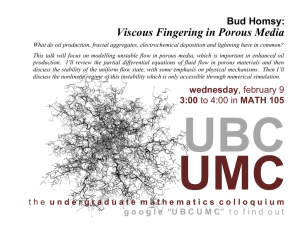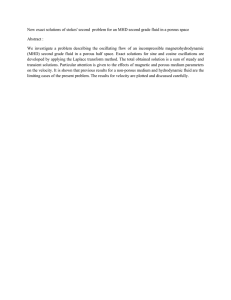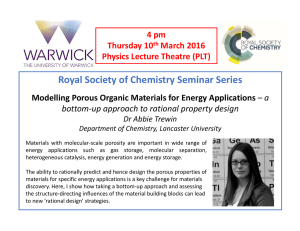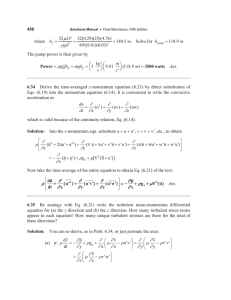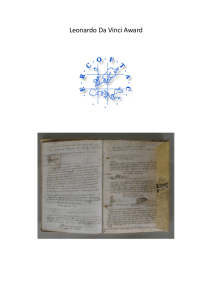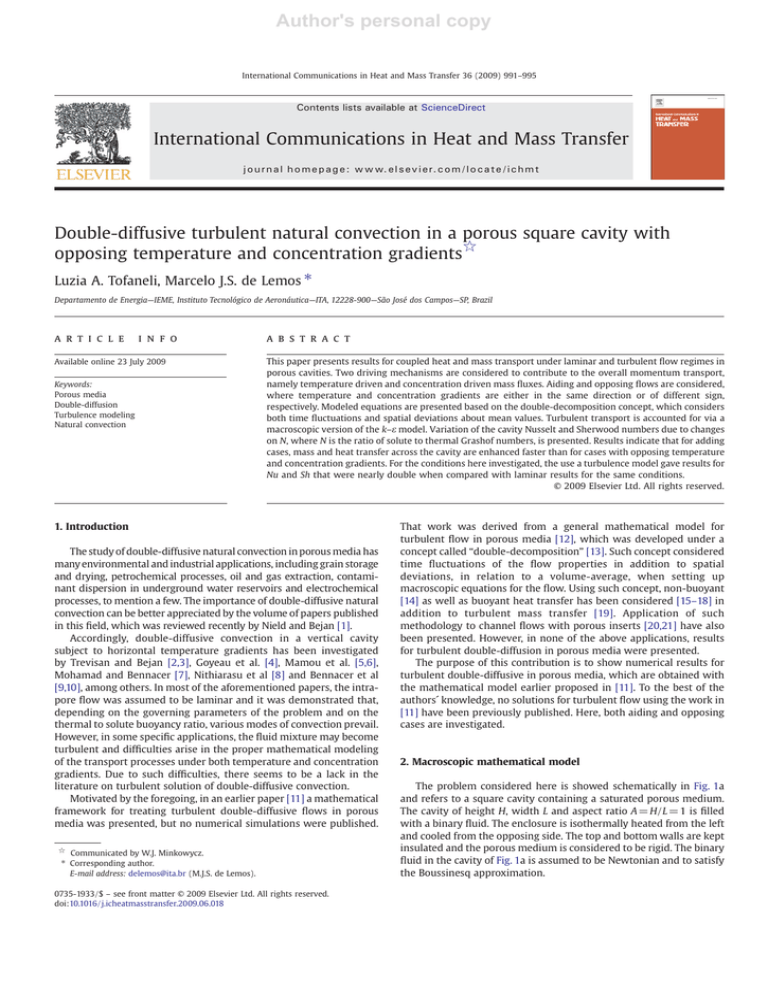
Author's personal copy
International Communications in Heat and Mass Transfer 36 (2009) 991–995
Contents lists available at ScienceDirect
International Communications in Heat and Mass Transfer
j o u r n a l h o m e p a g e : w w w. e l s ev i e r. c o m / l o c a t e / i c h m t
Double-diffusive turbulent natural convection in a porous square cavity with
opposing temperature and concentration gradients☆
Luzia A. Tofaneli, Marcelo J.S. de Lemos ⁎
Departamento de Energia—IEME, Instituto Tecnológico de Aeronáutica—ITA, 12228-900—São José dos Campos—SP, Brazil
a r t i c l e
i n f o
Available online 23 July 2009
Keywords:
Porous media
Double-diffusion
Turbulence modeling
Natural convection
a b s t r a c t
This paper presents results for coupled heat and mass transport under laminar and turbulent flow regimes in
porous cavities. Two driving mechanisms are considered to contribute to the overall momentum transport,
namely temperature driven and concentration driven mass fluxes. Aiding and opposing flows are considered,
where temperature and concentration gradients are either in the same direction or of different sign,
respectively. Modeled equations are presented based on the double-decomposition concept, which considers
both time fluctuations and spatial deviations about mean values. Turbulent transport is accounted for via a
macroscopic version of the k–ε model. Variation of the cavity Nusselt and Sherwood numbers due to changes
on N, where N is the ratio of solute to thermal Grashof numbers, is presented. Results indicate that for adding
cases, mass and heat transfer across the cavity are enhanced faster than for cases with opposing temperature
and concentration gradients. For the conditions here investigated, the use a turbulence model gave results for
Nu and Sh that were nearly double when compared with laminar results for the same conditions.
© 2009 Elsevier Ltd. All rights reserved.
1. Introduction
The study of double-diffusive natural convection in porous media has
many environmental and industrial applications, including grain storage
and drying, petrochemical processes, oil and gas extraction, contaminant dispersion in underground water reservoirs and electrochemical
processes, to mention a few. The importance of double-diffusive natural
convection can be better appreciated by the volume of papers published
in this field, which was reviewed recently by Nield and Bejan [1].
Accordingly, double-diffusive convection in a vertical cavity
subject to horizontal temperature gradients has been investigated
by Trevisan and Bejan [2,3], Goyeau et al. [4], Mamou et al. [5,6],
Mohamad and Bennacer [7], Nithiarasu et al [8] and Bennacer et al
[9,10], among others. In most of the aforementioned papers, the intrapore flow was assumed to be laminar and it was demonstrated that,
depending on the governing parameters of the problem and on the
thermal to solute buoyancy ratio, various modes of convection prevail.
However, in some specific applications, the fluid mixture may become
turbulent and difficulties arise in the proper mathematical modeling
of the transport processes under both temperature and concentration
gradients. Due to such difficulties, there seems to be a lack in the
literature on turbulent solution of double-diffusive convection.
Motivated by the foregoing, in an earlier paper [11] a mathematical
framework for treating turbulent double-diffusive flows in porous
media was presented, but no numerical simulations were published.
☆ Communicated by W.J. Minkowycz.
⁎ Corresponding author.
E-mail address: delemos@ita.br (M.J.S. de Lemos).
0735-1933/$ – see front matter © 2009 Elsevier Ltd. All rights reserved.
doi:10.1016/j.icheatmasstransfer.2009.06.018
That work was derived from a general mathematical model for
turbulent flow in porous media [12], which was developed under a
concept called “double-decomposition” [13]. Such concept considered
time fluctuations of the flow properties in addition to spatial
deviations, in relation to a volume-average, when setting up
macroscopic equations for the flow. Using such concept, non-buoyant
[14] as well as buoyant heat transfer has been considered [15–18] in
addition to turbulent mass transfer [19]. Application of such
methodology to channel flows with porous inserts [20,21] have also
been presented. However, in none of the above applications, results
for turbulent double-diffusion in porous media were presented.
The purpose of this contribution is to show numerical results for
turbulent double-diffusive in porous media, which are obtained with
the mathematical model earlier proposed in [11]. To the best of the
authors´ knowledge, no solutions for turbulent flow using the work in
[11] have been previously published. Here, both aiding and opposing
cases are investigated.
2. Macroscopic mathematical model
The problem considered here is showed schematically in Fig. 1a
and refers to a square cavity containing a saturated porous medium.
The cavity of height H, width L and aspect ratio A = H/L = 1 is filled
with a binary fluid. The enclosure is isothermally heated from the left
and cooled from the opposing side. The top and bottom walls are kept
insulated and the porous medium is considered to be rigid. The binary
fluid in the cavity of Fig. 1a is assumed to be Newtonian and to satisfy
the Boussinesq approximation.
Author's personal copy
992
L.A. Tofaneli, M.J.S. de Lemos / International Communications in Heat and Mass Transfer 36 (2009) 991–995
Nomenclature
A
cF
cp
C
Da
Ddisp
Ddisp,t
D
Dt
g
Giβ
Grcϕ
Grϕ
H
k
⟨k ⟩ i
K
Kdisp
Kdisp,t
Kt
Ktor
Le
N
Nu
p
Pr
Ra⁎
Sc
Sh
T
u
uD
aspect ratio
Forchheimer coefficient
specific heat
mass concentration
Darcy number, Da = K/H2
mass dispersion tensor
turbulent mass dispersion tensor
mass transfer coeffecient
turbulent mass flux tensor
gravity acceleration vector
Generation rate of ⟨ k ⟩ i due to buoyant effects
solute Grashof number based on H, Grcϕ =gβcϕΔCH3/v2
thermal Grashof number based on H, Grϕ =gβϕΔTH3/v2
height of enclosure
turbulent kinetic energy per unit mass, k = u0 ⋅u0 = 2
intrinsic (fluid) average of k
permeability
Conductivity tensor due to dispersion
Conductivity tensor due to turbulent dispersion
Conductivity tensor due to turbulent heat flux
Conductivity tensor due to tortuosity
Lewis number, Le = Sc/Pr = D/α
buoyancy ratio, N=Grcϕ/Grϕ, N=0 for thermal drive only.
Nusselt number
pressure
Prandtl number, Pr = v/α
Rayleigh–Darcy number, Ra ⁎ = Gr ϕPr Da (α/αeff),
αeff =λeff / (ρcp)f
Schmidt number, Sc = v/Dℓ
Sherwood number
temperature
velocity of the mixture
Darcy velocity vector
Greek symbols
α
fluid thermal diffusivity, α = λf/(ρcp)f
βϕ
macroscopic thermal expansion coefficient
βcϕ
macroscopic solute expansion coefficient
ΔC
concentration difference between plates, C1 − C2
ΔT
concentration difference between plates, T1 − T2
λ(s, f)
fluid/solid thermal conductivity
λeff
effective thermal conductivity, λeff = (1 − ϕ)λf + ϕλs
μ
fluid mixture viscosity
μtϕ
macroscopic turbulent viscosity
ε
dissipation rate of k
⟨ε ⟩ i
intrinsic (fluid) average of ε
ρ
bulk density of the mixture
ϕ
porosity
Subscripts
β
buoyancy
ℓ
chemical species
t
turbulent
ϕ
macroscopic
C
concentration
T
temperature
(s, f)
solid/fluid
Superscripts
i
intrinsic (fluid) average
v
volume (fluid + solid) average
Fig. 1. Configuration investigated: a) geometry and boundary conditions, b) stretched
grid.
The equations used herein are derived in details in [11–13] and for
that their derivation need not be repeated here. They are developed
based on volume-averaging procedures which are fully described in
the literature [22–25].
The macroscopic continuity equation is then given by,
∇uD = 0
ð1Þ
where the Dupuit–Forchheimer relationship, u D̅ = ϕ⟨u ̅⟩i, has been
used and ⟨u ̅⟩i identifies the intrinsic (liquid) average of the local
velocity vector u ̅. The macroscopic time-mean Reynolds equation for
an incompressible fluid with constant properties is given as,
ρ∇:
uD uD
0
0 i
i
2
= −∇ðϕ⟨p⟩ Þ + μ∇ uD + ∇⋅ð−ρϕ⟨u u ⟩ Þ
ϕ
i
i
−ρgϕ ½βϕ ð⟨T⟩ −Tref Þ + βCϕ ð⟨C⟩ −Cref Þ
μϕ
c ϕρj u j u
−
u + F pffiffiffiDffi D
K D
K
ð2Þ
where the last two terms in Eq. (2) represent the Darcy–Forchheimer
contribution. The symbol K is the porous medium permeability, cF is
the form drag coefficient (Forchheimer coefficient), ⟨ p ⟩ i is the
intrinsic average pressure of the fluid, ρ is the fluid density, μ
represents the fluid viscosity and ϕ is the porosity of the porous
medium. Buoyancy effects due to temperature and concentration
variations within the cavity are also shown in Eq. (2). The macroscopic
0 0
Reynolds stress −ρϕ⟨u u ⟩i is modeled as,
2
0
0 i
v
i
−ρϕ⟨u u ⟩ = μtϕ 2⟨D⟩ − ϕρ⟨k⟩ I
3
ð3Þ
Author's personal copy
L.A. Tofaneli, M.J.S. de Lemos / International Communications in Heat and Mass Transfer 36 (2009) 991–995
Transport equations for ⟨ k ⟩ i and its dissipation rate ⟨ε⟩i =
where
i
1h
v
i
i T
∇ðϕ⟨u⟩ Þ + ½∇ðϕ⟨u⟩ Þ
⟨D⟩ =
2
ð4Þ
i
0
0
i
is the macroscopic deformation tensor, ⟨k⟩ = ⟨u ⋅u ⟩ = 2 is the
intrinsic turbulent kinetic energy and μ tϕ is the turbulent viscosity,
which is modeled in [13] similarly to the case of clear flow, in the form,
2
μ tϕ = ρcμ
⟨k⟩i
⟨ε⟩i
ð5Þ
Coefficients βϕ and βcϕ in Eq. (2) are used to write the Grashof
numbers associated with the thermal and solute drives, in the form,
Grϕ =
gβϕ ΔTH
3
; GrCϕ =
ν2
gβCϕ ΔCH3
ν2
ð6Þ
where ΔT = T1 − T2 and ΔT = C1 − C2 are the maximum temperature
and concentration variation across the cavity, respectively. One should
note that for opposing thermal and concentrations drives, such maximum differences are of opposing sign. Also, the Rayleigh–Darcy number is a dimensionless parameter defined as Ra⁎ =gβϕΔTHK/vαeff, with
αeff =λeff /(ρcp)f.
The ratio of Grashof numbers defines the buoyancy ratio, N, in the
form
N=
993
GrCϕ
=
Grϕ
βCϕ ΔC
μ⟨∇u0 : ð∇u0 ÞT ⟩i = ρ including additional effects due to temperature
and concentration gradients are proposed as in [11]:
"
#
!
μt
i
i
i
i
i
i
i
ρ∇: uD ⟨k⟩ = ∇: μ + ϕ ∇ðϕ⟨k⟩ Þ + P + G + Gβ + GβC −ρϕ⟨ε⟩
σk
ð15Þ
μt i
i
ρ∇: uD ⟨ε⟩ = ∇: μ + ϕ ∇ ϕ⟨ε⟩
σε
i
+
3. Integral parameters
The local Nusselt number on the hot wall of the square cavity
(x = 0) is defined as,
!
∂⟨T⟩i
L
Nuy = hL = λeff ∴ Nuy =
ð17Þ
T1 −T2
∂x
x=0
where T1 and T2 refers to the temperature limits imposed at the cavity
lateral walls (Fig. 1). The average Nusselt number is then given by,
Nu =
giving for Eq. (2),
u u
0
0 i
i
2
ρ∇⋅ D D = −∇ðϕ⟨p⟩ Þ + μ∇ uD + ∇⋅ð−ρϕ⟨u u ⟩ Þ
ϕ
ΔT
i
i
ð⟨C⟩ −C ref Þ
−ρ gϕβϕ ð⟨T⟩ −T ref Þ + N
ΔC
cF ϕρ j uD juD
μϕ
pffiffiffiffi
−
u +
K D
K
ð16Þ
where c1, c2, c3 and ck are constants. The generation rate of k due to
buoyancy is represented by Giβ and Giβc for both the thermal and solute
drives, respectively [11].
ð7Þ
βϕ ΔT
⟨ε⟩
i
i
i
i
i
½c1 P + c2 G + c1 c3 ðGβ + GβC Þ−c2 ρϕ⟨ε⟩ ⟨k⟩i
1 H
∫ Nuy dy
H 0
ð18Þ
Likewise, the local Sherwood number on the wall where the
highest concentration prevails, or say, at x = 0 for adding drives and at
x = L for opposing cases, can be defined as,
ð8Þ
Either βcϕ = 0 or ΔC = 0 results in N = 0, or say, only thermal drive
applies. Also, for β cϕ = 0 and ΔC ≠ 0 in Eq. (8), although no
concentration drive is modeled, a distribution of C within the field
will occur due to the flow established by the thermal drive.
Additional transport equations read (see [11] for details).
Shy = hc L = D ∴ Shy =
∂⟨C⟩i
∂x
!
xwall
L
C1 −C2
ð19Þ
Here also 1 and 2 are subscripts referring to the maximum and
minimum concentration values, respectively, and hc is a film coefficient
for mass transfer. The average Sherwood number is then given by,
Sh =
1 H
∫ Shy dy
H 0
ð20Þ
The variables h and hc are local film coefficients for heat and mass
transfer, respectively.
2.1. Heat transport
i
i
ðρ cp Þf ∇⋅ðuD ⟨T⟩ Þ = ∇⋅ f Keff ⋅∇⟨T⟩ g
Keff = ½ϕ λf + ð1−ϕÞ λs I + Ktor + Kt + Kdisp + Kdisp;t
ð9Þ
ð10Þ
|fflfflfflfflfflfflfflfflfflfflfflfflfflfflfflffl{zfflfflfflfflfflfflfflfflfflfflfflfflfflfflfflffl}
λeff
4. Numerical details
The numerical method employed for discretizing the governing
equations is the control-volume approach. A hybrid scheme, which
includes both the Upwind Differencing Scheme (UDS) and the Central
Differencing Scheme (CDS), was used for interpolating the convection
2.2. Mass transport
i
i
∇ ⋅ðuD ⟨C⟩ Þ ¼ ∇ ⋅Deff ⋅∇ðϕ⟨C⟩ Þ
ð11Þ
Deff = Ddisp + Ddiff + Dt + Ddisp;t
ð12Þ
i
Ddiff = ⟨D⟩ I =
Dt + Ddisp;t
1 μϕ
I
ρ Sc
1 μtϕ
=
I
ρ Sct
Table 1
Average Nusselt and Sherwood numbers for thermal drive only, N = 0 with βcϕ = 0,
(Le = 10, A = 1).
Ra⁎
Imposed
conditions
Nu
ΔC
= 1;
ΔT
βCφ = 0
ð13Þ
Sh
ð14Þ
Present results
Goyeau et al. [4]
Trevisan and Bejan [2]
Present results
Goyeau et al. [4]
Trevisan and Bejan [2]
100
200
400
1000
2000
3.11
3.11
3.27
14.76
13.25
15.61
4.90
4.96
5.61
22.02
19.86
23.23
7.65
7.77
9.69
32.55
28.41
30.76
13.22
13.47
–
53.37
48.32
–
19.54
19.90
–
76.58
69.29
–
Author's personal copy
994
L.A. Tofaneli, M.J.S. de Lemos / International Communications in Heat and Mass Transfer 36 (2009) 991–995
fluxes. The well-established SIMPLE algorithm [26] was followed for
handling the pressure–velocity coupling. Individual algebraic equations sets were solved by the SIP procedure of [27]. In addition,
concentration of nodal points closer to the walls reduces eventual
errors due to numerical diffusion which, in turn, are further
annihilated due to the hybrid scheme here adopted. Calculations for
laminar and turbulent flows used a 80 × 80 stretched grid for all cases
(Fig. 1b). For turbulent flow calculations, wall log laws were applied.
5. Results and discussion
As mentioned, this work refers to the study of natural convective
flows in a porous cavity of height H, width L and aspect ratio A = H/
L = 1 saturated by a binary fluid. The flow is incompressible and a
two-dimensional steady state was assumed. Horizontal temperature
and concentration differences were specified between the vertical
walls (Fig. 1a).
The validation of the numerical code has been performed over a
large range of parameters for purely thermal natural convection in
porous media. Table 1 shows average Nusselt and Sherwood numbers
for laminar flow compared with those by [2] and [4]. Results in the
table consider mass transfer caused by thermal convection only
(N = 0). In this configuration, the solute buoyancy force is not present
but mass transfer across the cavity occurs due to the thermally driven
flow. The table shows good agreement with similar computations
presented in the literature and indicates correct programming of the
numerical code developed.
Simulations considering laminar and turbulent flow for ϕ = 0.8,
Ra⁎ = 2 × 106, Pr= 10, Grϕ = 2.25 × 1010, Da= 8.88× 10− 6, λeff =λs =λf
and Le= 1.0 are shown next. The buoyancy ratio N was varied from −5
to 5, for both model solutions.
Fig. 2 shows the average Nusselt and Sherwood numbers at the
heated wall as a function of N. For aiding flows (N N 0), Nu and Sh
increase with N. The figure also shows that there are significant
variations between the laminar and turbulent model solutions, with
integral values nearly doubling when turbulence is considered, at least
for the particular conditions presented in the figure.
The case for N = 0 indicates that convection is sole due to thermal
buoyancy. However, since the C-equation is also solved, the flow
mixes the concentration field and a corresponding Sherwood is
computed. The value of Nu is at minimum when N = −1, when the
two driving mechanisms oppose each other with equal strength.
Under such circumstances, conduction prevails across the cavity.
The figure further indicates that as N is decreased below −1,
negative buoyancy forces due to species distribution acts vertically
downward, along the heated wall, thereby opposing the vertically
upward thermal buoyancy drive. For that, transport rates are lower for
N b − 1 when compared with aiding cases having the same numerical
value of |N|. That is, laminar Nu and Sh for N = + 4 are 15% higher
than for N = − 4, for example. For turbulent solution, such differences
for the same values of N are around 23% for both Nu and Sh.
6. Conclusions
This work presents numerical computations for laminar and
turbulent flows using a macroscopic k–ε model with wall functions.
Double-diffusive natural convection in a square cavity, totally filled with
porous material, was simulated. The cavity was heated from the left and
cooled from the opposing side. For aiding laminar flows, predicted
integral parameters were 15% higher when compared with flows with
similar but opposing conditions. For adding turbulent flows, Nu and Sh
values are roughly 23% higher than for the cases of opposing flows, at
least for the conditions here simulated.
Acknowledgments
The authors would like to thank the CNPq and the FAPESP, Brazil,
for their invaluable financial support during the preparation of this
work.
References
Fig. 2. Comparison of integral parameters as functions of the buoyancy ratio N for turbulent
and laminar model solutions, Ra⁎ = 2 × 106, Grϕ = 2.25× 1010, Da = 8.88× 10− 6, λeff =λs =
λf and ϕ= 0.8: a) Nusselt number; b) Sherwood number.
[1] D.A. Nield, A. Bejan, Convection in porous media, Springer, Berlin, 1999.
[2] O.V. Trevisan, A. Bejan, Natural convection with combined heat mass transfer
buoyancy effects in a porous medium, International Journal Heat and Mass
Transfer 28 (1985) 1597–1611.
[3] O.V. Trevisan, A. Bejan, Mass and heat transfer by natural convection in a vertical slot
filled with porous medium, International Journal Heat and Mass Transfer 29 (1986)
403–415.
[4] B. Goyeau, J.P. Songbe, D. Gobin, Numerical study of double-diffusive natural
convection in a porous cavity using the Darcy–Brinkman formulation, International Journal of Heat and Mass Transfer 39 (7) (1996) 1363–1378.
[5] M. Mamou, P. Vasseur, E. Bilgen, Multiple solutions for double-diffusive convection in
a vertical porous enclosure, International Journal of Heat and Mass Transfer 38 (10)
(1995) 1787–1798.
[6] M. Mamou, M. Hasnaoui, A. Amahmid, P. Vasseur, Stability analysis of double
diffusive convection in a vertical Brinkman porous enclosure, International
Communications in Heat and Mass Transfer 25 (4) (1998) 491–500.
[7] A.A. Mohamad, R. Bennacer, Double diffusion natural convection in an enclosure
filled with saturated porous medium subjected to cross gradients; stably stratified
fluid, International Journal of Heat and Mass Transfer 45 (18) (2002) 3725–3740.
[8] P. Nithiarasu, T. Sundararajan, K.N. Seetharamu, Double-diffusive natural convection in a fluid saturated porous cavity with a freely convecting wall, International
Communications in Heat and Mass Transfer 24 (8) (1997) 1121–1130.
[9] R. Bennacer, A. Tobbal, H. Beji, P. Vasseur, Double diffusive convection in a vertical
enclosure filled with anisotropic porous media, International Journal of Thermal
Sciences 40 (1) (2001) 30–41.
[10] R. Bennacer, H. Beji, A.A. Mohamad, Double diffusive convection in a vertical
enclosure inserted with two saturated porous layers confining a fluid layer,
International Journal of Thermal Sciences 42 (2) (2003) 141–151.
[11] M.J.S. de Lemos, L.A. Tofaneli, Modeling of double diffusive turbulent natural
convection in porous media, International Journal Heat Mass Transfer 47 (2004)
4233–4241.
[12] M.H.J. Pedras, M.J.S. de Lemos, Computation of turbulent flow in porous media
using a low-Reynolds k-epsilon model and an infinite array of transversally
displaced elliptic rods, Numerical Heat Transfer Part A-Appl. 43 (6) (2003)
585–602.
Author's personal copy
L.A. Tofaneli, M.J.S. de Lemos / International Communications in Heat and Mass Transfer 36 (2009) 991–995
[13] M.J.S. de Lemos, Fundamentals of the double-decomposition concept for turbulent
transport in permeable media, Materialwissenschaft und Werkstofftechnik 36 (10)
(2005) 586–593.
[14] F.D. Rocamora Jr., M.J.S. de Lemos, Analysis of convective heat transfer for turbulent
flow in saturated porous media, International Communications Heat and Mass
Transfer 27 (6) (2000) 825–834.
[15] E.J. Braga, M.J.S. de Lemos, Turbulent natural convection in a porous square cavity
computed with a macroscopic k-ε model, International Journal Heat and Mass
Transfer 47 (26) (2004) 5639–5650.
[16] E.J. Braga, M.J.S. de Lemos, Heat transfer in enclosures having a fixed amount of
solid material simulated with heterogeneous and homogeneous models, International Journal Heat and Mass Transfer 48 (23–24) (2005) 4748–4765.
[17] E.J. Braga, M.J.S. de Lemos, Simulation of turbulent natural convection in a porous
cylindrical annulus using a macroscopic two-equation model, International
Journal Heat and Mass Transfer 49 (23–24) (2006) 4340–4351.
[18] E.J. Braga, M.J.S. de Lemos, Laminar and turbulent free convection in a composite
enclosure, International Communications Heat Mass Transfer 52 (2009) 588–596.
[19] M.J.S. de Lemos, M.S. Mesquita, Turbulent mass transport in saturated rigid porous
media, International Communications Heat Mass Transfer 30 (2003) 105–113.
995
[20] M. Assato, M.H.J. Pedras, M.J.S. de Lemos, Numerical solution of turbulent channel
flow past a backward-facing-step with a porous insert using linear and non-linear
k-ε models, Journal of Porous Media 8 (1) (2005) 13–29.
[21] N.B. Santos, M.J.S. de Lemos, Flow and heat transfer in a parallel-plate channel with
porous and solid baffles, Numerical Heat Transfer Part A-Appl. 49 (5) (2006)
471–494.
[22] C.T. Hsu, P. Cheng, Thermal dispersion in a porous medium, International Journal
Heat Mass Transfer 33 (1990) 1587–1597.
[23] J. Bear, Dynamics of fluids in porous media, Dover, New York, 1972.
[24] S. Whitaker, Equations of motion in porous media, Chem. Eng. Sci. 21 (1966) 291.
[25] S. Whitaker, Diffusion and dispersion in porous media, J. Amer. Inst. Chem. Eng 3 (13)
(1967) 420.
[26] S.V. Patankar, D.B. Spalding, A calculation procedure for heat, mass and
momentum transfer in three dimensional parabolic flows, International Journal
Heat Mass Transfer 15 (1972) 1787.
[27] H.L. Stone, Iterative solution of implicit approximations of multidimensional
partial differential equations, SIAM J. Numer. Anal. 5 (1968) 530–558.

